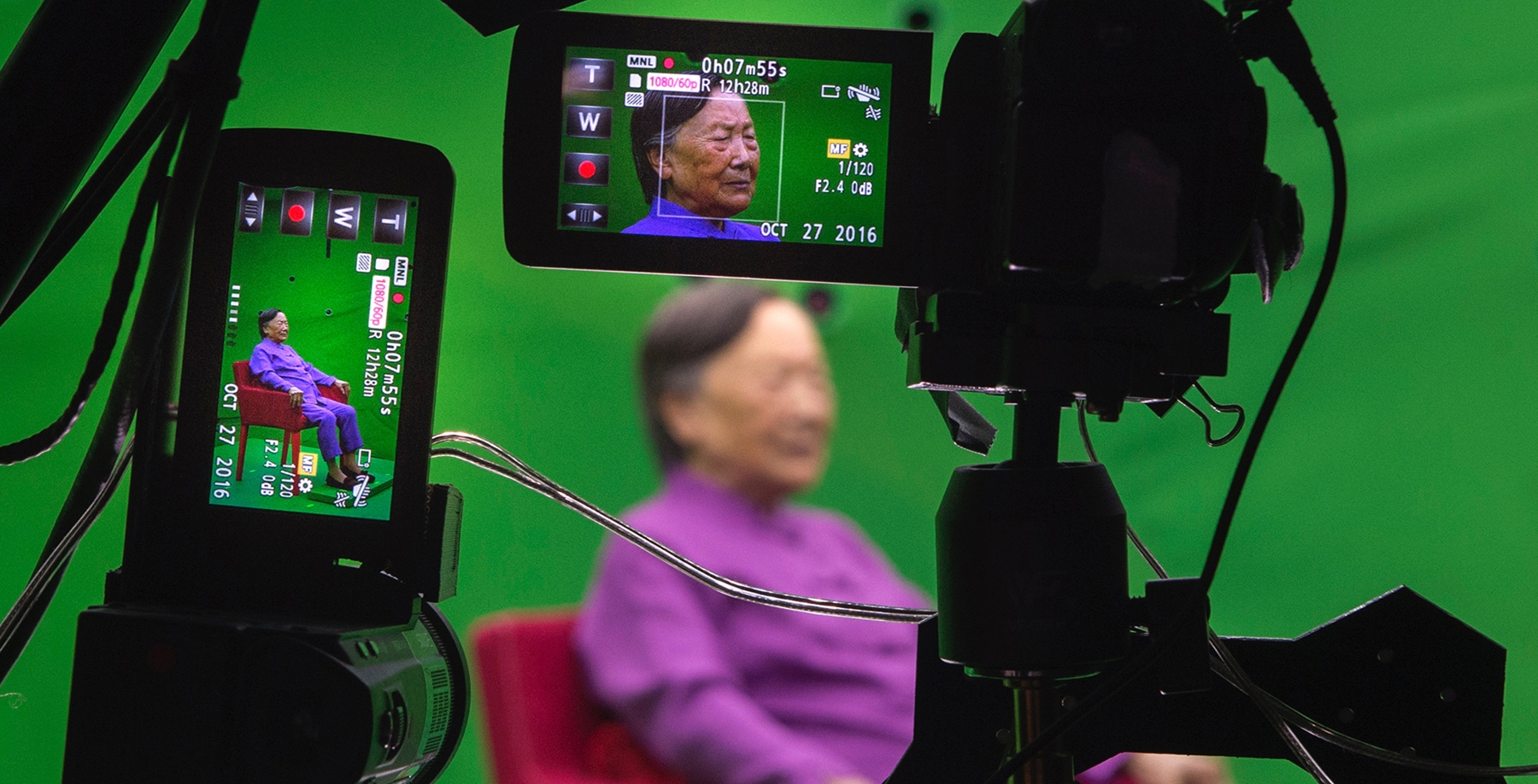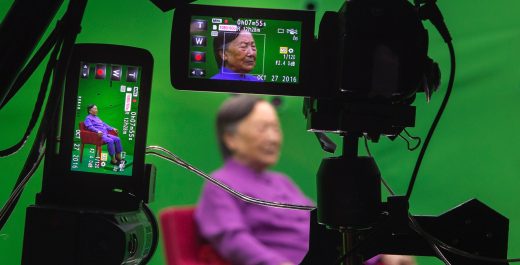A Nanjing Massacre survivor’s story lives on digitally
On the morning of December 13th, 1937, Japanese troops pounded on the door of Xia Shuqin’s family home in Nanjing, China. Thirteen people had taken shelter under this particular roof: Eight-year-old Xia, her mother and father, two grandparents, four sisters (one, four, 13 and 15 years old), and four neighbors. The Japanese army had ridden into the city on horseback that morning and faced little resistance; the Chinese army had made a full, chaotic retreat the prior evening, December 12th.

When Xia’s father answered the door, the Japanese soldiers immediately shot and killed him. They bludgeoned and killed her one-year-old sister. They raped and killed her mother. They killed her grandparents. They raped and killed her 13-year-old and 15-year-old sisters. And they bayoneted Xia three times in the arm and back.
My grandparents were survivors of World War II, and though they were not from Nanjing, they ran and hid from the Imperial Japanese Army during the invasion of Guangzhou. I was only a child when I heard their stories of rape and pillage and thus lacked the wherewithal to ask follow-up questions. What I know is from scattered oral accounts over a period of years.
One of my grandmothers had to flee her home. When she returned, nearly all the animals on her family’s farm were dead — the chickens, even the dog — save for a single ox. The other grandmother served as a nurse for the Chinese army and had to “hide in the mountains.” She saw little Chinese boys “seated” upright on the ends of bayonets. The sort of surreal imagery that was both terrifying and dizzying — too awful to be real.
When I learned about World War II in my American elementary and middle schools, there was zero mention of Japanese war atrocities. My grandparents’ stories felt like alternate, secret histories that I was privy to — sordid and illegitimate, and things that should not be told in mixed, non-Chinese company.
Author and historian Iris Chang led a charge against this sentiment. She published The Rape of Nanking, a historical nonfiction account of the Nanjing Massacre, in 1997. Like me, Chang was an American: She learned about the Japanese war atrocities from her parents, who fled Nanjing before the Japanese sacked the city.
Chang wrote her book to expose the massacre to a wider, Western audience. She researched her subject for two years, even traveling to Nanjing to interview and document survivors’ accounts; among them was Madame Xia’s. And though her book was widely praised and commercially successful — it stayed on The New York Times‘ best-seller list for ten weeks — there was also a backlash to its historical objectivity.
The harshest critics were Japanese nationalists who denied the massacre ever happened in the first place and conflated any inaccuracies in the text to prove this point. But even critics who sympathized with the work expressed that perhaps Chang was too close to the material, that her emotions had clouded her judgment and she was playing one too many roles: on one hand, an unbiased historian and on the other hand, an Asian-American activist who wanted to hold the Japanese government accountable for its misdeeds. Perhaps her written tone had compromised her ethos.
But when I read The Rape of Nanking, I was floored that Chang could take these faded oral accounts, these intangible narratives from my childhood, and give them form with the sort of indignation and blunt horror that befitted them. Chang’s palpable outrage may not have been academic. But the book felt factual and truthful in a manner that a dispassionate recounting would not have. She wanted to do more than simply take down the survivors’ version of events; she also wanted to preserve the survivors’ pain, pride and humanity.
In Tim O’Brien’s novel The Things They Carried, there is a chapter called “How To Tell A True War Story.” O’Brien’s protagonist, an American Vietnam War veteran, makes the argument that a well-told war story captures an emotional truth that cannot be qualified or compromised.
“True war stories do not generalize,” O’Brien writes. “They do not indulge in abstraction or analysis. For example: War is hell. As a moral declaration the old truism seems perfectly true, and yet because it abstracts, because it generalizes, I can’t believe it with my stomach. Nothing turns inside.
“It comes down to gut instinct,” O’Brien concludes. “A true war story, if truly told, makes the stomach believe.”
Iris Chang committed suicide in 2004; she was researching the Bataan Death March at the time of her passing. In the years since, Dr. Ying-Ying Chang, her mother, has taken up her daughter’s activism. The Nanjing survivors whom Iris brought to Western audiences’ attention have not forgotten her either; there is a statue of her likeness at Nanjing Massacre Memorial Hall, the same place where Madame Xia’s digital likeness is installed.
When I spoke to Iris’ mother via phone, she expressed her daughter’s oft-stated sentiments: that the Japanese government has still not properly atoned for its crimes against the Chinese people. She cited Germany, which underwent a denazification after World War II, as a model example of how to facilitate the healing process.
No survivor’s account is exactly alike, especially with how she chooses to frame the experience in retrospect. And Madame Xia was specifically chosen for this project based on her hopeful outlook toward the future.
“She is a very well-known and recognized individual for speaking out about her story and for the memory not to fade,” said Karen Jungblut, director of collections at the USC Shoah Foundation. “She promotes peace and the learning experience from her story.”
“We have a long relationship with her.” said Cheng Fang, a USC Shoah Foundation research specialist who conducted the interview in Los Angeles. “When we had the idea to invite her here [to the United States] to conduct this interview, we were kind of worried about her physical condition. She was already 87 years old, and it would take her 15 hours, even on a direct flight, to come here. But she insisted that she would come to do this interview.
“Madame Xia always had this concept that the Westerners — including the Americans — had saved her life,” continued Fang. “She said that she wanted to come to America to express her gratefulness. We asked her, and without any hesitation, she said yes. She fears that one day, when she’s no longer here, there will be no one to tell her story.”
“She said the experience added more years of life to her,” added Jungblut. “As difficult as it was at times, she was extremely grateful. And I think she enjoyed doing this — telling her story and being a part of this.”
Time and again, the Nanjing Massacre is questioned and debated over raw statistics. How many people were raped? How many people were killed? Was it 200,000? Was it 300,000? The cruel irony of war is that both of these figures are numbing in their scope and near impossible to comprehend. They are a statistical monstrosity that threaten to distance us from the horror rather than draw us closer.
But personal narratives give those awful numbers intimacy. And there is an elusive, emotional truth derived from human contact and interplay. One person speaks. Another person listens, processes and responds. Back and forth. Back and forth. It is difficult to deny or refute something so primal and raw. It ensures that the victims — and their lives, loves and losses — are front and center, where they belong. They tell factual stories, but more importantly, they tell true stories, ones that do not generalize. They tell stories that make the stomach believe.
Xia and her four-year-old sister were the only survivors of this onslaught. And for the next ten days, the girls hid inside the house — only moving and searching for food at night — while the Japanese pillaged the rest of the city. The International Military Tribunal for the Far East, convened after World War II to prosecute Japanese war crimes, estimates that 200,000 Chinese were killed over a period of six weeks; China’s official estimate is 300,000 dead. Twenty thousand Chinese women were raped, a number that does not include children or the elderly. Many of those women were then mutilated and killed afterward. But Xia and her sister were found by neighbors and taken to the Nanjing Safety Zone, a demilitarized zone established by Westerners to shelter Chinese refugees from the war.
Today, Madame Xia is 88 years old. She is part of a dwindling population of Nanjing Massacre survivors; when she dies, all that will be left of her story is what historians and organizations can capture through video, audio and textual records.
The University of Southern California Shoah Foundation is one such organization that records and preserves survivor testimony, most recently through its New Dimensions in Testimony (NDT) initiative. In 2014, the USC Shoah Foundation piloted a digital rendition of Pinchas Gutter, a Polish Holocaust survivor who was only seven years old at the start of World War II. Spectators could ask Gutter a question, and the digital rendition would answer it. It is made possible through a combination of voice recognition technology, natural language processing and thoroughness: The Shoah Foundation recorded Gutter for more than 20 hours and asked him more than 1,500 questions to exhaust the possibilities of what a student might ask him.
On December 12th, 2017, the 80th anniversary of the Nanjing Massacre, the Nanjing Memorial Hall in Nanjing, China, debuted a digital rendition of Madame Xia, the latest and most technologically advanced NDT project. There are many firsts to this debut. This is the first time an NDT exhibit has been permanently installed outside the United States. This is the first time the USC Shoah Foundation has recorded a non-Holocaust survivor for NDT. And this is the first time the NDT language processing has been done in Mandarin. There are plans to make these interactive testimonies available online, possibly in the next few years.
Sponsored by the Sichuan Tianfu Bank and Tianfu Group, the new installation at Nanjing Massacre Memorial Hall will create a greater sense of immediacy to an atrocity that, until now, has been passively experienced by people who did not survive or witness the events.
“When I first saw a demonstration of New Dimensions in Testimony with a Holocaust survivor, I quickly understood how important it would be to bring the technology to the people of China,” Hao Wu, president of China Tianfu, said in a Shoah Foundation press release. “A lot of people worked hard to make this happen, but without the generous cooperation of Madame Xia, this would not have been possible.”
Take away dispassionate documentation and history can become a subjective mess, both to people who want to nail down its specifics and to naysayers who might minimize events or deny they happened. But primary accounts are also valuable. Enough of them will form a consensus. And what they lack through subjectivity, they gain through emotional immediacy and impact.
(39)













